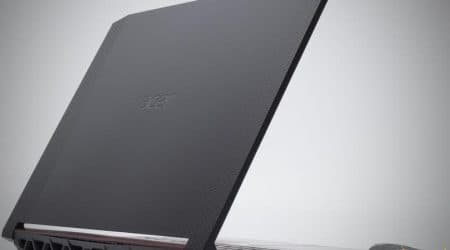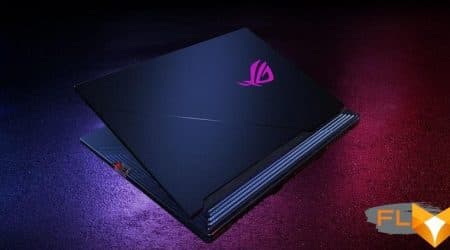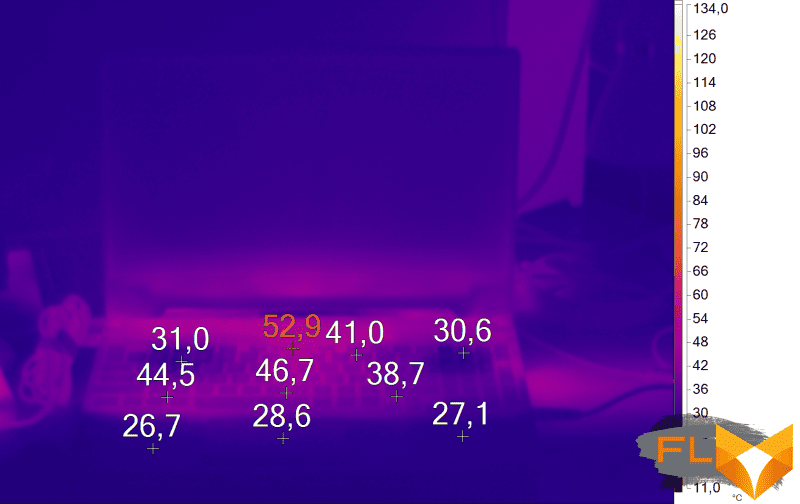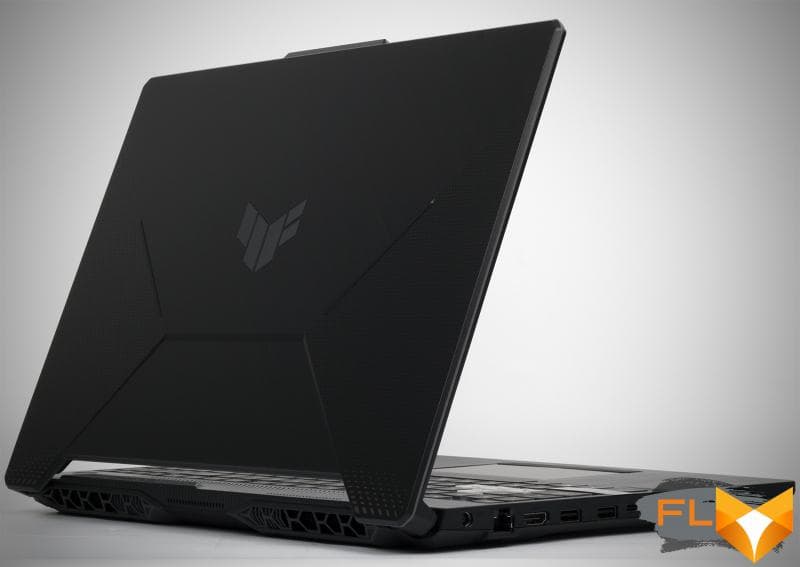


May novelties from Intel and NVIDIA slowly reach the shelves of domestic computer stores. The processor giant has unveiled the long-awaited 10nm Tiger Lake chips, and the greens have released the GeForce RTX 3050 and 3050 Ti graphics, the most affordable Ampere generation chips equipped with RT cores. It so happened that the novelties of both chipmakers are simultaneously used in the ASUS TUF Gaming F15 (FX506H) laptop, which will be discussed later.
ASUS TUF Gaming F15 (FX506H)
⇡#Specifications, equipment and software
The Gaming F15 series, updated in 2021, includes a fairly large number of modifications. All possible characteristics of TUF gaming laptops are presented in the table below.
| ASUS TUF Gaming F15 (FX506H) | |
| Primary display | 15.6″, 1920×1080, IPS, 240Hz 15.6″ 1920×1080 IPS 144Hz 15.6″, 1920 × 1080, IPS, 60Hz |
| CPU | Intel Core i5-11400H Intel Core i7-11800H Intel Core i9-11900H Intel Core i5-11260H |
| Video card | NVIDIA GeForce RTX 3050 (75W with Dynamic Boost) NVIDIA GeForce RTX 3060 (95W with Dynamic Boost) NVIDIA GeForce RTX 3050 Ti (75W with Dynamic Boost) |
| RAM | Up to 32GB DDR4-3200 |
| Install Drives | 2 × M.2 in PCI Express x4 3.0 / SATA 6Gb/s mode |
| Interfaces | 3 × USB 3.2 Gen1 Type-A 1 x Thunderbolt 4 1 x 3.5mm mini jack 1 x HDMI 1 × RJ-45 |
| Built-in battery | 48 or 90 Wh |
| External power supply | 180W |
| Dimensions | 359 × 228 × 24 mm |
| Notebook weight | 2.3kg |
| Operating system | Windows 10 Home Windows 10 Pro |
| Warranty | 1 year |
| Recommended retail price | from $1200 |
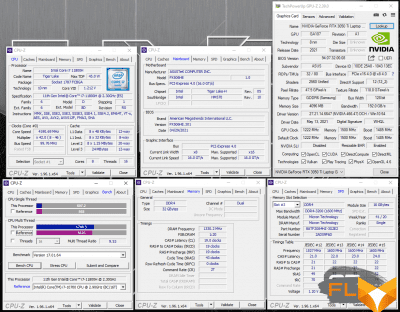 | 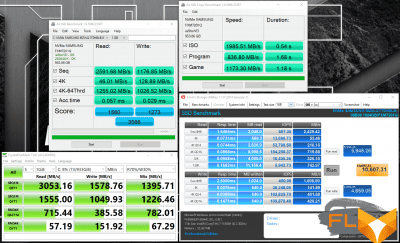 |
A rather advanced version of the TUF Gaming F15 came to our office, which has an 8-core Core i7-11800H, GeForce RTX 3050 Ti (75 W with Dynamic Boost activated), 32 GB of DDR4-3200 memory and 1 TB SSD. The laptop also has a MediaTek MT7921 wireless module that supports IEEE 802.11b/g/n/ac/ax and Bluetooth 5.2 standards. Unfortunately, at the time of this writing, I did not find a single ASUS TUF Gaming F15 of this year for sale.
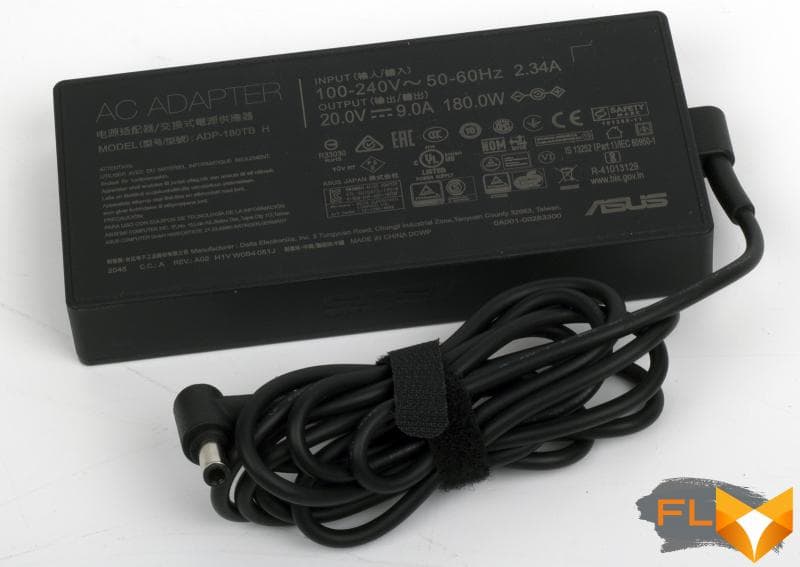
The TUF Gaming F15 comes with a fairly compact 180W external power supply. Together with all the wires, its weight is 500 grams.
⇡#Appearance and Input Devices
I love the look of the TUF Gaming F15. The Black Graphite version has arrived, but you can find the Gray Eclipse configuration on sale – in both cases we are talking about profile display covers, equipped with uncomplicated patterns and inscriptions. In both cases, we are talking about a completely plastic case, which, however, is trying to mimic aluminum – we are still dealing with a more affordable TUF series, and not with ROG STRIX, for example. Nevertheless, the F15 promises to be durable: they are certified according to the military standard MIL-STD-810H. This means that the device passed various tests: the laptop was dropped, heated, shaken, cooled and doused with water – and now it got to the editorial office (just kidding).
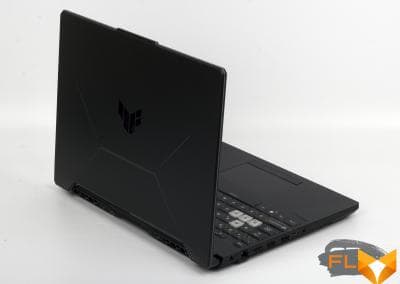 | 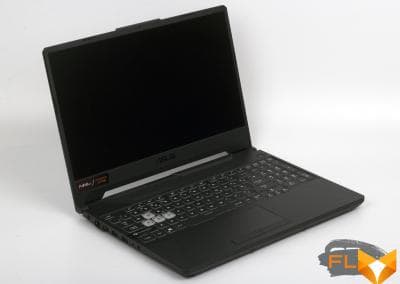 |
The laptop lid opens about 135 degrees. The case received rather tight hinges, but you can still open the lid with one hand. The hinges clearly position the screen and keep it from dangling during gaming sessions.

The novelty, as befits modern laptops, is elegant. This is largely achieved through thin frames on the sides. On the left and right, their thickness is only 6.5 mm. Above and below, however, – noticeably more. Otherwise, if we continue the topic of size, the TUF Gaming F15 received fairly typical characteristics: its thickness is slightly less than 25 mm, and its weight is 2.3 kg without an external power supply.
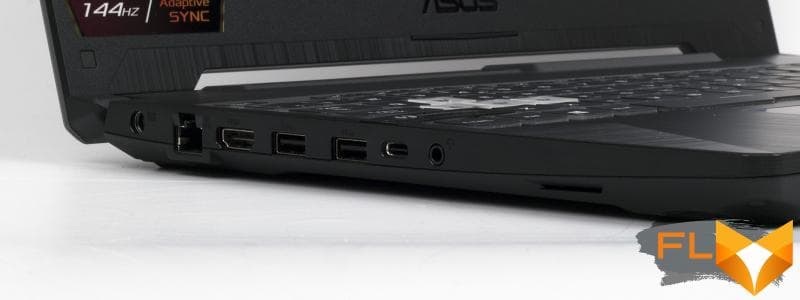
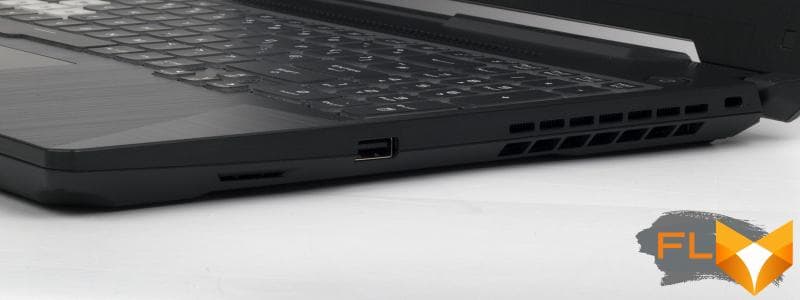
The main interfaces are located at the TUF Gaming F15 on the left side. Here you will find a port for connecting a power supply, an RJ-45 port for a Realtek gigabit controller, an HDMI output, two USB 3.2 Gen1 A-types, a 3.5mm mini-jack for connecting headphones, and Thunderbolt 4 combined with a mini-DisplayPort. On the right side of the laptop there is only one USB 3.2 Gen1 A-type.
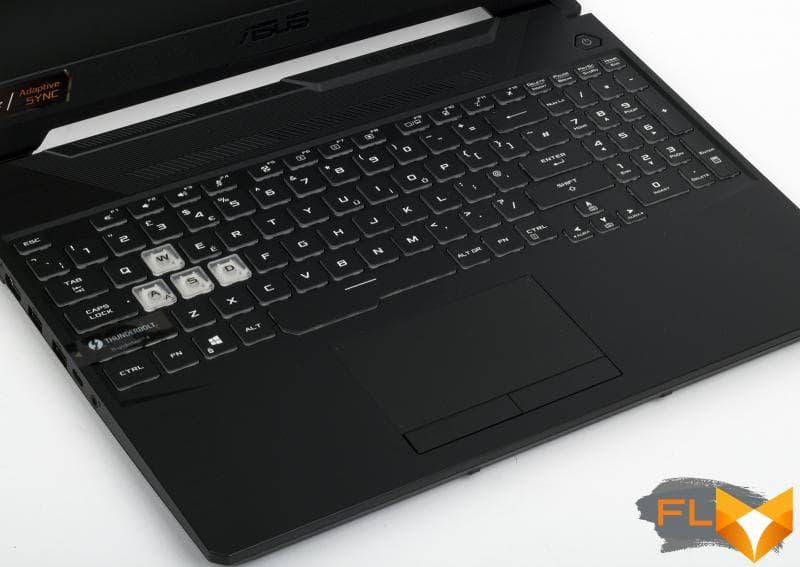
The keyboards of the 15-inch TUF Gaming, as usual in the series, have a number pad – yes, some especially impressionable readers will rejoice! All keys are illuminated in the same way – four modes of operation and more than 16 million colors are available. The WASD button block received white cases. The keyboard supports Overstroke technology, which increases the number of keystrokes. The resource of each button is 20 million clicks.
There are no serious complaints about the keyboard layout, but some buttons will definitely take some getting used to. Personally, I would like to have large Enter, Ctrl and left Shift in the arsenal. It is inconvenient to use only the arrow keys – they are traditionally very small in ASUS laptops. The power button is located where it should be – away from the rest of the keys.
The device’s webcam runs at 720p at 30Hz. As you understand, the image quality of such a webcam is very lame. And if a muddy and noisy picture is enough for Skype calls, then, for example, for streaming on Twitch and YouTube sites, it’s definitely not.
⇡#Internal design and upgrade options
The laptop is very easy to disassemble: you just need to slowly and carefully disconnect the bottom from the rest of the case.
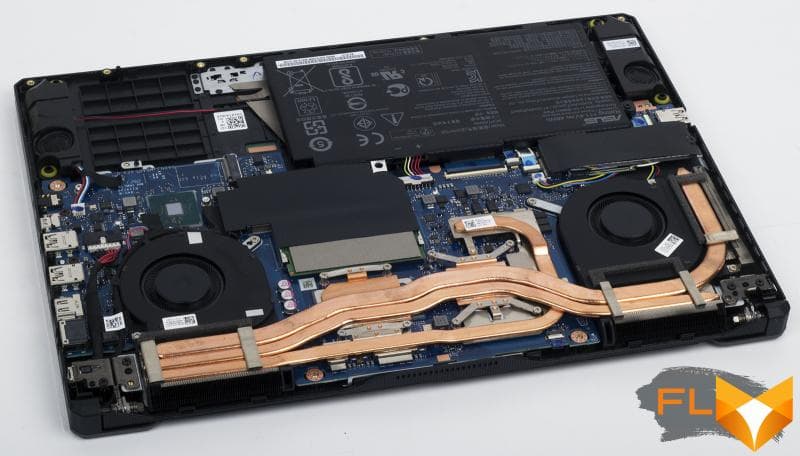
The cooling system for the CPU, GPU and related components has two tangential fans, three copper heat pipes and three copper heatsinks. Each impeller received 83 blades 0.25 mm thick. According to ASUS, this design increases airflow by 10% compared to previous generation coolers.
The laptop is easy to upgrade, as it allows you to change both the RAM and ROM in the system. By default, our assembly already has 32 GB of DDR4-3200 memory, but you can buy another SSD for the Samsung MZVLQ1T0HBLB solid-state drive – the second M.2 connector is empty.
⇡#Test Methodology
The methodology for testing gaming laptops focuses on computer games. Laptop performance was measured using the following software.
Games (Full HD resolution):
- World of Tanks EnCore RT. DirectX 11. Benchmark. Ultra mode, RT off
- Counter Strike: Global Offensive. DirectX 9. FPS Benchmark map. Multi-core processing – incl. Maximum quality.
- The Witcher III: Wild Hunt. DirectX 11. Novigrad and surroundings. Maximum quality.
- GTA V. DirectX 11. Built-in benchmark. Maximum quality, FXAA + 2x MSAA, advanced quality settings on, 16x AF, image resolution scaling off
- PlayerUnknown’s Battlegrounds. DirectX 11. Training mode. Ultra Mode
- Shadow of the Tomb Raider. DirectX 12. Built-in benchmark. Maximum quality, DXR – off, TAA.
- Assassin’s Creed Valhalla. DirectX 12. Built-in benchmark. Highest mode.
- Battlefield V. DirectX 12. The Last Tiger mission. Ultra Mode, TAA, DXR Off
- Red Dead Redemption 2. Vulkan. Built-in benchmark. Maximum quality (advanced settings – off), TAA.
- Gears 5. DirectX 12. Built-in benchmark. Ultra Mode
- Metro: Exodus. DirectX 12. Built-in benchmark. Ultra Mode
- Horizon Zero Dawn. DirectX 12. Built-in benchmark. Top quality, TAA.
- Death Stranding. DirectX 12 Prologue. Maximum quality.
- A Total War Saga: TROY. DirectX 11. Built-in benchmark. Max mode, 4x AA
- DOOM Eternal. Vulcan. Beginning of the game. Ultra Mode
- Watch Dogs: Legion. DirectX 12. Built-in benchmark. Maximum quality, TAA, DXR off, DLSS off
- Cyberpunk 2077. DirectX 12. City trip. Impressive quality mode, DXR off, DLSS off
Gaming performance was measured using the well-known CapFrameX program. It allows you to get the rendering time of each frame. The use of the 99th percentile instead of the minimum frames per second is due to the desire to clean up the results from random performance fluctuations that were provoked by reasons not directly related to the operation of the main components of the platform.
Testing the laptop in games and applications was carried out with the activation of the fastest mode suitable for these tasks.
Applications:
- Corona 1.3. Testing rendering speed using the renderer of the same name. Measures the build speed of the standard BTR scene used to measure performance.
- Blender 2.92. Determining the speed of the final rendering in one of the popular free packages for creating three-dimensional graphics. The duration of building the final model pavillon_barcelona_v1.2 from Blender Benchmark is measured.
- x265 HD Benchmark. Testing the speed of video transcoding to H.265/HEVC format. The tables and graphs show the average integer value obtained after five runs of the test.
- CINEBENCH R23. Measuring the performance of photorealistic 3D rendering in the CINEMA 4D animation package, CPU test. The tables and graphs show the average integer value obtained after five runs of the test.
- Adobe Premiere Pro 2020 – Rendering a project in 4K resolution.
- Topaz Video Enhance AI v1.2.3. Performance testing in an AI-based program to improve video detail. The test uses the original video at 1280×720 resolution, which is scaled up by 150% using the Artemis-HQ model: P, HQ, MC.
Comprehensive benchmarks:
- Futuremark PCMARK10 Professional Edition 2.1.2177. Testing in Essentials scenarios (typical work of an average user: launching applications, surfing the Internet, video conferencing), Productivity (office work with a text editor and spreadsheets), Digital Content Creation (creation of digital content: photo editing, non-linear video editing, rendering and 3D visualization -models).
- 3DMark Professional Edition 2.11.6846. Testing in Time Spy and Fire Strike scenes.
- Unigine Superposition Benchmark. 1080p Extreme testing.
Notebook testing in resource-intensive applications was carried out in the default mode without any adjustment of the parameters of the central processor and cooler.
Display testing is performed using the X-Rite i1Display Pro colorimeter and the DisplayCAL 3 application.
The battery life of the laptop was tested in two modes. The first load option – web surfing – involves alternately opening and closing the tabs of the 3DNews.ru, Computeruniverse.ru and Unsplash.com sites with an interval of 30 seconds. For this test, the current version of the Google Chrome browser at the time of testing is used. In the second mode, .mkv video is played in Full HD resolution in the built-in player of Windows OS with the repeat function activated. In all cases, the same display brightness was set to 200 cd / m2, and the keyboard backlight (if any) and the sound were turned off.
In games and other applications, the results of the following laptops are considered:
| Test Participants | ||||||
| Model | Screen | Processor | RAM | Graphics | Accumulator | Battery |
| MSI GE66 Raider (2021) | 15.6”, 1920 × 1080 | Intel Core i7-10870H, 8/16 cores/threads, 2.2 (5.0) GHz, 45W | 16 GB DDR4-3200 Dual Channel | NVIDIA GeForce RTX 3070 Notebook 8GB GDDR6 | SSD 512 GB | 99.9 Wh |
| ASUS Zephyrus G15 | 15.6”, 2560 × 1440 | AMD Ryzen 7 5800HS 8/16 cores/threads 2.8 (4.4) GHz 35W | 16 GB DDR4-3200 Dual Channel | NVIDIA GeForce RTX 3070 Notebook 8GB GDDR6 | SSD, 1TB | 90 Wh |
| GIGABYTE AORUS 15G KC | 15.6”, 1920 × 1080 | Intel Core i7-10870H, 8/16 cores/threads, 2.2 (5.0) GHz, 45W | 16 GB DDR4-3200 Dual Channel | NVIDIA GeForce RTX 3060 Notebook 6GB GDDR6 | SSD 512 GB | 99 Wh |
| ASUS ROG Zephyrus G14 GA401 (2021) | 14”, 2560 × 1440 | AMD Ryzen 9 5900HS 8/16 Cores/Threads 3 (4.6) GHz 35W | 32 GB DDR4-3200 Dual Channel | NVIDIA GeForce RTX 3060 Notebook 6GB GDDR6 | SSD, 1TB | 76 Wh |
| ASUS TUF Gaming F15 (FX506H) | 15.6”, 1920 × 1080 | Intel Core i7-11800H, 8/16 cores/threads, 2.3 (4.6) GHz, 45W | 32 GB DDR4-3200 Dual Channel | NVIDIA GeForce RTX 3050 Ti Notebook 4GB GDDR6 | SSD, 1TB | 48 Wh |
⇡#Display and sound
The product card says that TUF Gaming F15 is equipped with as many as three types of IPS matrices, the vertical frequency of which is 60, 144 and 240 Hz. Moreover, the fastest display also demonstrates excellent color reproduction – 100% sRGB. Consider this if you need a laptop not only for entertainment, but also for content creation. In our case, we use a 144 Hz BOE NV156FHM-NX3 matrix, and it has an average image quality – I already talked about this, since we tested laptops with such a display before.
| ASUS TUF Gaming F15 (FX506H) (Matrix – BOE NV156FHM-NX3) | |
| Minimum brightness | 16 cd/m2 |
| Maximum brightness | 271 cd/m2 |
| Color temperature | 7027K |
| Contrast | 957:1 |
| sRGB gamut | 55% |
| Adobe RGB color gamut | 38% |
| Grey scale deviation: average (maximum) | 2.25 (3.26) |
| Extended test deviation: mean (maximum) | 5.77 (24.22) |
| Viewing angles | corresponds to the declared |
| Glow effect | present |
| PWM | not seen at all brightness levels |

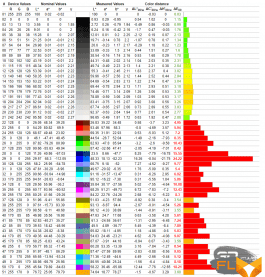 | 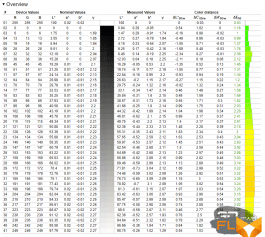 | 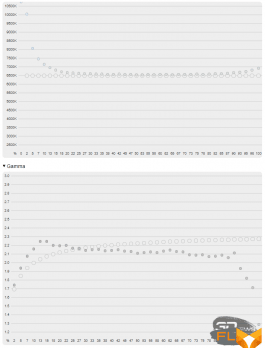 |
The TUF Gaming F15 speakers have a good volume margin – enough to listen to music in the apartment and watch movies. However, the sound quality itself is average. On the one hand, there is bass, albeit accompanied by extraneous echoes. On the other hand, the upper and middle frequencies sound very flat and … plastic, or something. So I would buy a good headset or Bluetooth speaker for a laptop.
⇡#Efficiency of the cooling system
In the test configuration of the laptop, quite powerful chips are used. Intel octa-cores have never been known for their energy efficiency, and the mobile GeForce RTX 3050 Ti in Dynamic Boost mode (always on and not configurable) consumes up to 75 watts in games that do not require a lot of CPU processing power. As always, we tested the ASUS laptop in Turbo and Performance modes.
| Summary of laptop operation and setup | ||
| Laptop mode | Turbo | Performance |
| Declared GPU Speed (Boost) and Memory Speed | 1585 MHz, 12.24 Gbps | 1485 MHz, 12 Gbps |
| Cyberpunk 2077 Real GPU Clock: Min, Max, Average | 1605 MHz | 1485 MHz |
| 1740 MHz | 1575 MHz | |
| 1678 MHz | 1550 MHz | |
| Max noise level | 44 dBA | 41.1 dBA |
| Average Power: GPU, CPU | 61W | 60W |
| 44W | 39 W | |
| GPU Temperature: Average, Maximum | 76 °C | 78 °C |
| 78 °C | 79 °C | |
| CPU temperature: average, maximum | 85 °C | 84 °C |
| 97 °C | 95 °C | |
| Performance | ||
| 3DMark Time Spy, points | 6205 | 5964 |
| 3DMark Fire Strike scores | 13678 | 12950 |
| Unigine Superposition, 1080p Extreme, points | 3459 | 3318 |
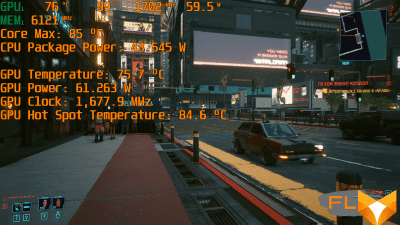 | 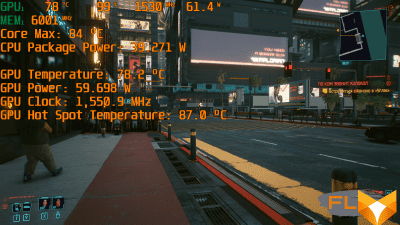 | |
Notebook case heating (games, nominal operation)
The laptop does not overheat in both modes: when the Performance preset is turned on, the temperatures turn out to be even higher, and the performance is lower, but this was done on purpose, since the noise level of the laptop is decently reduced. In the case of using Turbo, we are dealing with a very noisy computer, and in the case of using the second mode, the noise level can be called tolerable, although quite noticeable. However, each user perceives the noise emitted by the laptop in his own way, and for normal operation there is a headset.
And yet I do not observe overheating of the chips. Yes, the averages of 85 and 76 degrees Celsius can be called high – especially in the case of the Core i7-11800H, but we have plenty of examples when laptop chips heat up even more. So the TUF Gaming F15 cooler fully copes with its main task.
CO also performs well in work applications, because the processor frequency is kept at 3.7 GHz in Adobe Premiere Pro 2020, and the PL1 indicator varies in the range from 70 to 80 watts. Yes, the hottest core of an 8-core processor heats up to 92 degrees Celsius on average, but the laptop BIOS setting allows the chip to operate at maximum frequency. Looking ahead a little, I will say that this approach had a good effect on the performance of the laptop.
| Laptop cooling performance in Adobe Premiere Pro 2020 | ||
| Turbo | ||
| CPU frequency | Medium | 3.7GHz |
| CPU Temperature | Maximum | 98 °C |
| Medium | 92 °C | |
| Noise level | Maximum | 43 dBA |
| CPU Power Consumption | Average | 72W |
| Test task execution time (less is better) | 705 s | |
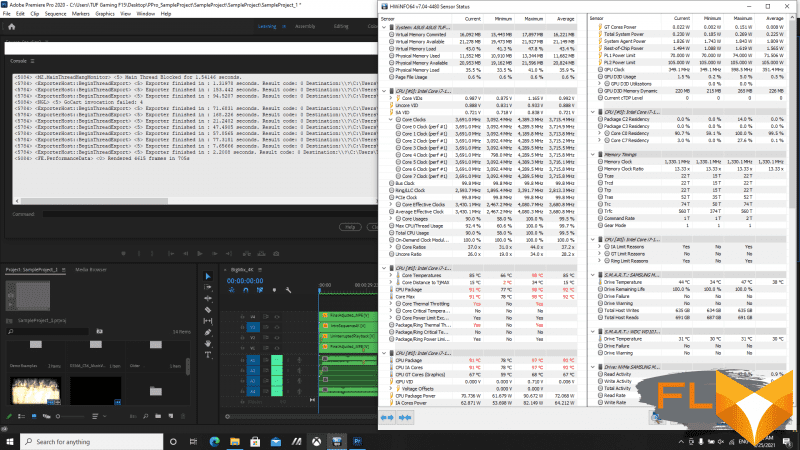
⇡#Laptop performance
As mentioned earlier, now the GeForce RTX 3050 and GeForce RTX 3050 Ti are considered the junior Ampere mobile graphics – by the way, discrete versions of video cards with the same names have not yet been presented. In the first case, we are talking about a stripped-down GA107 processor, in the second, a full-fledged one. So, the GeForce RTX 3050 Ti for laptops uses 2560 CUDA cores, 80 tensor cores, and 20 RT cores. The declared operating frequency range of the GPU is from 1035 to 1695 MHz (the laptop manufacturer can adjust the TDP of the chip in the range from 35 to 80 W). In the case of the TUF Gaming F15, the GPU runs at a Boost frequency of 1585 MHz in Turbo mode. It turns out that on sale it will be possible to meet laptops with slightly faster versions of the GeForce RTX 3050 Ti.
The GeForce RTX 3050 is based on a stripped-down version of the GA107, equipped with 2048 CUDA cores, 64 tensor cores, and 16 RT cores. The graphics processor of this model operates in the frequency range of 1057-1740 MHz, which varies depending on the TDP (35-80 W).
Any variation of the GA107 is equipped with 4 GB of GDDR6 video memory with a 128-bit interface.
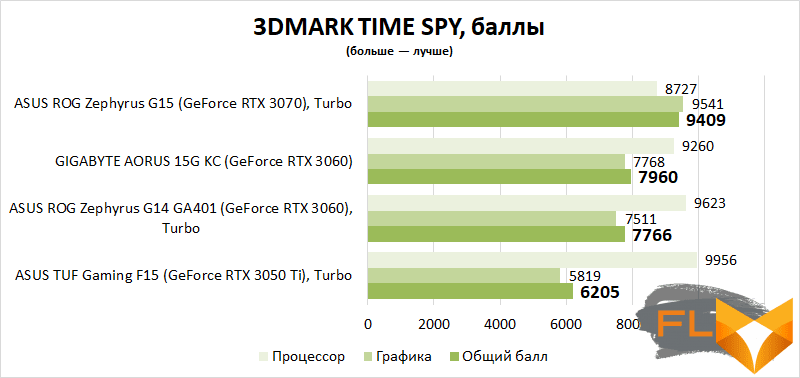
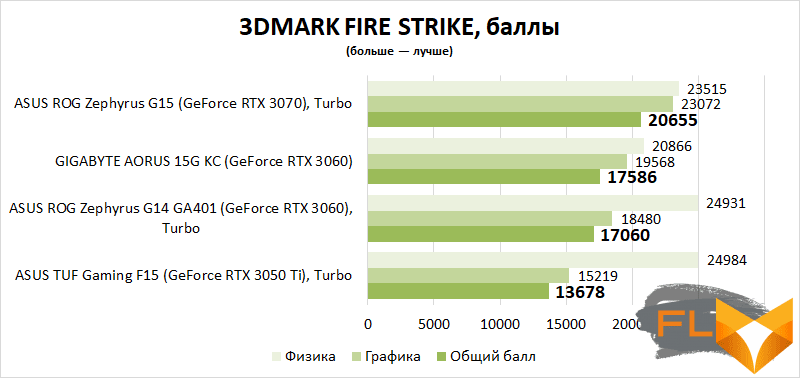

Let’s compare the performance level of TUF Gaming F15 and ROG Zephyrus G14 – both laptops were tested in “Turbo” mode in graphics benchmarks. Let me remind you that the GeForce RTX 3060 graphics in the ASUS laptop runs at 80 W when Dynamic Boost technology is enabled. We see that the Zephyrus is faster than the TUF Gaming F15 by 25-33%, and this is a pretty decent difference, in my opinion. In games, of course, it can be both significantly smaller and noticeably larger. Because:
- Dynamic Boost works differently on laptops and depends, for example, on the efficiency of the laptop cooler.
- Full HD resolution is processor dependent.
- The performance of the GeForce RTX 3050 Ti is also affected by the presence of only 4 GB of VRAM.
To give you a good example, with the introduction of Re-Size BAR technology support, we can set the graphics quality level to Absolute Nightmare in DOOM Eternal even for graphics with 4 GB of VRAM. And it seems that TUF Gaming F15 demonstrates an excellent average FPS, only framerate drawdowns constantly appear. To really comfortably crush demons in Doom, you have to lower the quality to the “High” value – it doesn’t matter for a spinal shooter, but 4 GB of video memory is frankly not enough in 2021 for AAA games.
However, in general, a comfortable FPS (with drawdowns of at least 30 frames per second) is observed in 12 out of 17 games. This is a good result, in my opinion. In other cases, we can safely say that laptops with the GeForce RTX 3050 Ti are more suitable for medium and high quality graphics when it comes to AAA projects. You must understand this before buying a laptop. But such a model as TUF Gaming F15 will perfectly cope with games 3-5 years ago.
| Test results in games, FPS (more is better) | ||
| Full HD | ||
| AVG | 1% MIN | |
| World of Tanks | 132 | 87 |
| CS:GO | 304 | 69 |
| PlayerUnknown’s Battlegrounds | 114 | 92 |
| The Witcher III: Wild Hunt | 71 | 54 |
| GTA V | 72 | 50 |
| Shadow of the Tomb Raider | 68 | 53 |
| Assassin’s Creed Valhalla | 7 | 5 |
| Red Dead Redemption 2 | 51 | 40 |
| Gears 5 | 66 | 48 |
| Metro: Exodus | 42 | 24 |
| Death Stranding | 88 | 69 |
| A Total War Saga: TROY | 49 | 38 |
| Horizon Zero Dawn | 66 | 50 |
| Watch Dogs: Legion | 27 | 21 |
| Battlefield V | 75 | 54 |
| Cyberpunk 2077 | 32 | 23 |
| DOOM Eternal | 104 | 28 |
Finally, Intel introduced high-performance 10nm Tiger Lake chips. However, the new 6- and 8-core models did not become some kind of revelation, because last year low-voltage CPUs with Willow Cove cores were introduced, and already this year Rocket Lake generation chips equipped with Cypress Cove cores were released for the LGA1200 platform, which are quite closely related to Tiger Lake, but are still manufactured on 14nm process standards. You can read more about Tiger Lake in our article “Architecture of 11th Generation Intel Core Processors”.
The Core i7-11800H isn’t the fastest Intel chip in the 11-series Core, but it’s definitely going to be used more often than other models in gaming laptops. With all that said, it’s no surprise that Intel’s new 8-core chip easily outperforms the Core i7-10870H found in the GIGABYTE AORUS 15G. It operates at a slightly higher frequency (3.7 GHz versus 3.6 GHz in Adobe Premiere Pro 2020), and has a noticeably faster microarchitecture. But at the same time, in most cases, the Core i7-11800H is inferior to the 8-core Ryzen 7 5800HS and Ryzen 9 5900HS.
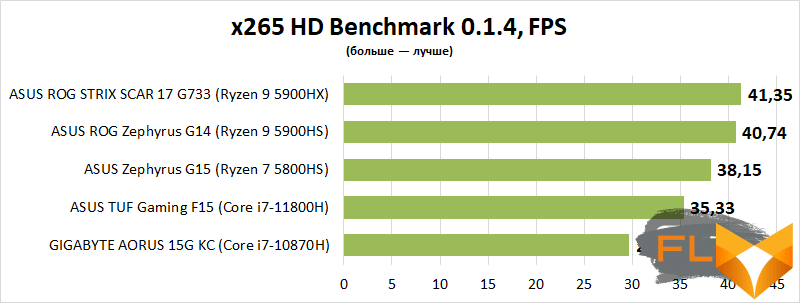
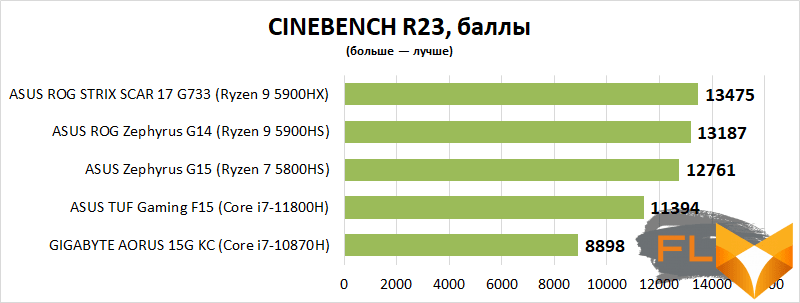
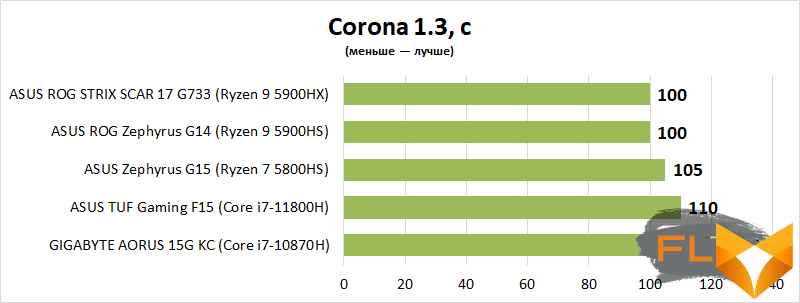
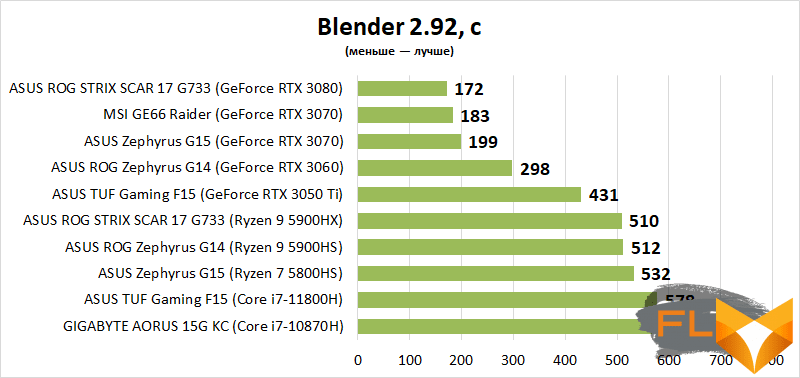
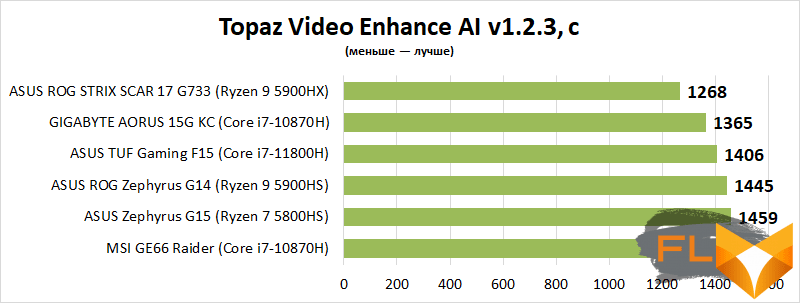
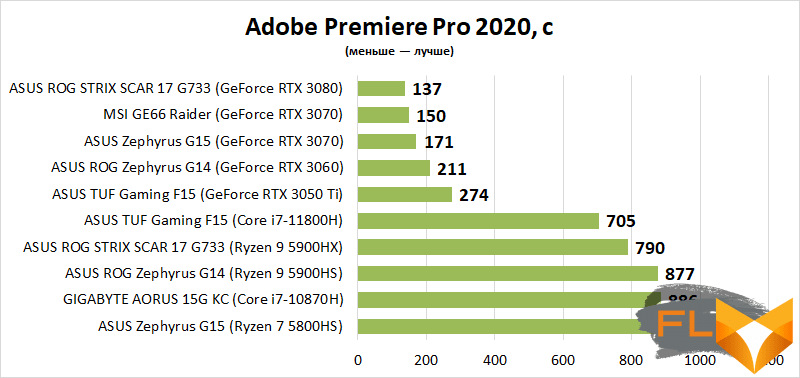
The performance of Tiger Lake in single-threaded work scenarios has also increased significantly. So, TUF Gaming F15 is ahead of GIGABYTE AORUS 15G in the PCMARK 10 benchmark by 8%, although the latter has faster GeForce RTX 3060 graphics. At the same time, in the Essentials and Productivity subtests, which simulate everyday user tasks, the ASUS laptop is faster by 9 and 13% respectively. The performance of the TUF Gaming F15 is also affected by the use of Samsung’s cool SSD.

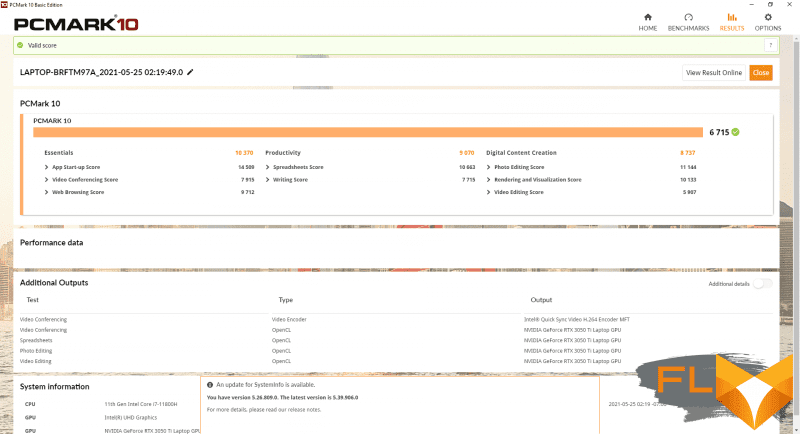
⇡#Laptop offline
Versions of the TUF Gaming F15 are equipped with 48 and 90 Wh batteries – we got a model with a less capacious battery. As a result, the review hero with a display brightness of 200 cd / m2 is able to work for more than four hours in light usage scenarios such as surfing the web and watching videos. Satisfactory result for a battery of this capacity. It is clear that if the laptop is mainly used at home, then there is not much point in chasing a more capacious battery – and vice versa, if you prefer to work away from an outlet, then why not look at a version with a more capacious battery.
| Battery life, screen brightness 200 cd/m2 | |
| Web | 4 hours 11 minutes |
| View video | 4 hours 10 minutes |
⇡#Conclusions
I have no particular complaints about the tested version of the TUF Gaming F15 – especially since I do not know the real price of this model. It is clear that this series, unlike the same ROG STRIX, is a kind of compromise solution, because it saved on case materials, display and thermal interface. But at the same time, in terms of performance, the hero of the review is unlikely to be much inferior to more status laptops with similar hardware. Although it works noisy, I must admit. As always, in the question “Do you want checkers or go?“, everyone will decide for himself what to choose.
The laptop is to be commended for its keypad with numeric keypad and functionality, as well as for its efficient (albeit noisy) CO operation and the ability to seamlessly change removable storage devices.
The performance of the GeForce RTX 3050 Ti was not a revelation for us. Alas, the newly introduced NVIDIA GPU is not capable of delivering comfortable FPS in fresh AAA games using very high quality graphics. Imposes its limitations and the presence of only 4 GB of VRAM. But there’s nothing to be done: laptops with noticeably faster GeForce RTX 3060 graphics already cost significantly more, all other things being equal. When more laptops with GeForce RTX 3050 and GeForce RTX 3050 Ti appear on the market – and it becomes clear how much such models cost – it will be possible to evaluate the feasibility of buying such a system compared to buying mobile PCs based on the GeForce GTX 1660 Ti and GeForce RTX 2060 But for the time being, it is rather difficult to do this.



